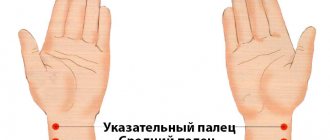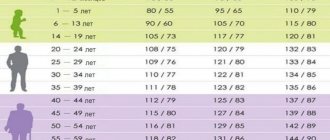The level of blood pressure (BP) in a person is determined by two indicators - upper and lower pressure. The top indicator is scientifically called systolic pressure, and the bottom is diastolic pressure. Together, both indicators show how correctly the heart muscle (myocardium) works, and its normal functioning depends on the work of the large arteries. They are a buffer that prevents the negative influence of external factors on human organs and systems.
After contraction of the cardiac sac, the arterial valve takes a closed position, due to which the flow of blood stops, and the flow of blood from the pulmonary artery, enriched with oxygen, begins. At the next beat, the process changes and blood moves throughout the body. The indicator that is responsible for normal blood flow is the lower, diastolic.
Pressure measurement procedure
Usually, a person’s systolic, upper, pressure increases, and the lower depends on it and jumps on its own in very rare cases. If its level is stably elevated simultaneously with the upper level or in isolation, essential hypertension is diagnosed. To determine whether a person’s circulatory and cardiovascular systems are functioning normally, one should also know about pulse pressure - this is the difference between the upper and lower limits of both indicators.
To determine blood pressure values, there is a special device - a tonometer. The devices are now sold as automatic, semi-automatic and manual, which are gradually going out of fashion as new affordable and improved models become available. The automatic tonometer independently determines to what level air needs to be pumped into the cuff to fully record the result.
But when using a hand-held device, you should adhere to a certain algorithm of actions:
- the cuff is fixed at a distance of 2–3 cm from the elbow, after which air intake begins using a rubber bulb;
- the size of the cuff should not be larger or smaller than the volume of the arm, it is better to choose the appropriate one for the correct measurement results;
- blood pressure is measured in a quiet environment, 30–40 minutes after the last meal;
- During the procedure, the person should not move, laugh or talk;
- the pressure gauge scale should be in front of the eyes, and the air should be pumped 30–40 mmHg higher than the expected systolic pressure;
- To record the readings as accurately as possible, measurements are taken on both hands twice, with an interval of 3–5 minutes.
No ads 1
After the measurements, the readings are deciphered if the procedure was performed correctly, taking into account the following points. The upper indicator (systolic) is recorded at the first audible pulse beat in the overstretched arm; it is the cardiac one. The systolic indicator indicates the force with which the heart pushes blood into the blood vessels. A person’s lower pressure is recorded when the heart muscle relaxes; it indicates the ability of the capillary walls to resist blood flow.
Pressure indicators depend on various factors - systolic characterizes the functioning of the myocardium, and diastolic depends on the functioning of the renal system (it is the kidneys that produce the hormone renin, which is responsible for the tone and elasticity of capillaries). The more elastic and durable a person’s blood vessels are, the more normal the diastole is.
High blood pressure danger
A hypertensive crisis (high blood pressure or BP) is a condition when blood pressure rises quickly and sharply, with readings of 180/120 or higher. The consequences of uncontrolled blood pressure in this range can be serious and include:
- stroke;
- loss of consciousness with dangerous injuries;
- memory loss;
- acute cardiovascular diseases;
- eye damage and visual disturbances;
- loss of kidney function;
- aortic dissection;
- angina pectoris (unstable chest pain);
- Pulmonary edema (fluid reserve in the lungs).
If you have been diagnosed with high blood pressure, monitor your readings and take your medications. During an emergency, having the notes with you can provide valuable information to the medical team providing treatment.
What does the change in indicators depend on?
The permissible minimum difference between the upper and lower values, as well as the normal blood pressure for people depending on age, will be described below. But the reasons for the jumps in these numbers can be various reasons. As a result of numerous studies, it has been proven that the standard of living, external factors and health status in general affect the results of blood pressure assessment.
If for one person an increase in indicators by 10–20 units is considered normal, then for another it can turn into a disaster.
In 90% of cases, overestimation of blood pressure is recorded in obese people, and age also affects blood pressure levels. In an elderly person, blood vessels lose their former elasticity, and the body as a whole and the cardiovascular system in particular undergo age-related changes - as a result, blood pressure increases. However, over the past decades, signs of persistent hypertension have also been observed in very young people aged 30–35 years.
No ads 2
The following factors influence this:
- nature of the diet;
- bad habits (smoking and alcohol abuse);
- lack of proper rest;
- excessive brain and physical activity, leading to exhaustion of the body;
- emotional overload and frequent stressful situations.
If the pressure is increased by 10–20 units after intense physical activity (sports, carrying heavy weights), this is absolutely normal and, after a while, the indicators will return to the initial values on their own. Blood pressure is usually reduced during sleep and immediately after waking up, since the body is in a state of rest and relaxation.
Completing all vital processes, before going to bed, the body also reacts with a jump in blood pressure by 10–20 units. Low blood pressure occurs in women during the menstrual cycle, during pregnancy, and in men during colds.
Situations in which there is a large difference in blood pressure
Often the problem is that a person does not know how to measure blood pressure correctly. Even if you don’t read the information on the Internet or consult a doctor, the box with each tonometer comes with instructions for measurement, but few people read it.
In more rare cases, the situation is aggravated due to the fact that the person does not understand which arm to measure blood pressure on and constantly does it on different limbs. Gradually, the difference in blood pressure begins to increase, but the patient will not know about it until visible symptoms occur.
Situations associated with pressure differences are as follows:
- One limb has normal pressure and the other has high pressure. In this case, the problem often lies in the development of VSD and anatomical abnormalities of the aorta and other arteries supplying the arms.
- High blood pressure on one limb and even higher on the other. This situation occurs due to the development of hypertension, VSD, as well as due to stress, overload and lack of sleep.
- Low pressure on one limb and high or normal pressure on the other. In this case, we are often talking about blockage of the artery or its compression.
The situations listed above do not arise immediately, but only after a long time. That is why it is important not only to understand on which arm the pressure should be measured, but also to periodically carry out the procedure on both limbs. In this case, the occurrence of many pathologies can be avoided.
Norm of upper and lower blood pressure
Constant fixation of indicators within 120/80 or 140/90 means that a person’s heart muscle and renal system are functioning correctly, and there is no reason to worry about health. In young people, indicators of 90/60 are considered normal, if the person feels well and does not complain of dizziness, weakness and weather sensitivity.
Weak pulse with high blood pressure
Also, indicators of upper and lower blood pressure are divided according to the norm depending on age groups:
- 16–20 years – normal values are 100/70, 120/80;
- 20–45 years – there is no reason to worry if the pressure is fixed at 120/70, 130/80;
- 50–60 years – normal blood pressure is 140/90;
- over 60 years old - blood pressure fluctuates within 150/90.
A gradual increase in blood pressure with age is the result of changes in the condition of the vascular walls, capillaries lose their former elasticity, and the heart muscle wears out. If you do not keep the aging process and natural wear and tear of the body under control, a disease may develop that affects all internal organs and systems and requires correction with medications - it is called hypertension.
The first degree of hypertension occurs with an increase in systolic pressure to 160 mm Hg, the second degree is diagnosed at the upper level of 180 mm Hg, and the third (dangerous to health and life) is characterized by surges in systolic blood pressure above 180 mm Hg.
What causes high blood pressure
For most people, there is no single cause for high blood pressure. However, there are a number of factors that increase the likelihood of developing hypertension. These are the so-called risk factors - controllable and uncontrollable. You can adjust:
- . When a person smokes, the incoming nicotine increases blood pressure. Over time, this damages the arteries, increasing the risk of heart attack or stroke.
- Eating excess processed foods and salt. Many processed foods contain a lot of salt. Excess salt intake causes the body to store excess water, which increases blood pressure.
- Drinking excess alcohol too often. Drinking alcohol temporarily increases blood pressure. Excessive alcohol consumption on a regular basis can lead to hypertension.
- Excess weight. Excess weight increases the risk of high blood pressure. Even losing just a few pounds can lower your blood pressure.
- Insufficient activity. If a person moves more and sits less, blood pressure decreases.
- . Hormones produced by the body during stress increase blood pressure. Researchers are still trying to understand the exact link between long-term high blood pressure and ongoing stress.
Uncontrollable risk factors include:
- . If a patient has type 1 or type 2 diabetes, they are twice as likely to develop high blood pressure.
- Kidney disease or other gland problems. Sometimes a serious disease that affects the kidneys, arteries, heart, or endocrine system can cause high blood pressure.
- Aging. Blood pressure naturally increases with age.
- Taking certain medications, such as birth control pills.
- A parent or sibling with high blood pressure. High blood pressure runs in families, so if parents or siblings have problems, the risk of hypertension increases.
Normal difference between systolic and diastolic pressure
The difference between the upper and lower blood pressure readings is called pulse pressure (PP), normally it is 40 units. A deviation in both directions of 5–10 units is allowed; this condition is not considered critical, therefore, if the normal PD is 30–50 units, there is no cause for concern. Both the physical and mental state of a person’s health can affect pulse pressure.
No ads 3
Insufficient nutrition, weather sensitivity, physical activity and emotional stress can temporarily reduce PD values, but when normal living conditions are restored, they return to normal on their own. A large, stable difference between systolic and diastolic pressure indicates pathologies developing in the body, the causes and etiology of which need to be clarified with the help of doctors.
A change in well-being will be noted when the PD deviates by more than 10 units in one direction or the other. For example, if a person has always recorded a difference between blood pressure readings of 50 units, then a drop in the norm to 30 units will already affect his condition, he may be talking about the emergence of health problems. Even if the pulse pressure remains within acceptable limits, it will still be considered low.
Choosing a hand for measuring blood pressure
Many people are concerned about the question: on which hand the pressure is measured, because the accuracy of the final numbers may depend on this. Doctors advise taking measurements on both limbs, and then doing another circle. Before measuring the pressure 2 times, you need to wait 3-4 minutes. The results obtained should be recorded. They will help you choose which arm to measure the pressure on correctly, since from now on it will be possible to carry out the procedure on the limb on which the readings were too high.
Sometimes blood pressure readings in both limbs are the same. In this case, you can understand on which hand to measure the pressure based on other criteria, for example, whether a person is right-handed or left-handed.
If the right limb is used predominantly, then the measurement should be carried out on the left, and vice versa.
Reasons for changes in pressure
The change in pressure can be short-term, but can also be systematically repeated. The reasons may be:
- Sensitivity to food, including allergic reactions;
- Hormonal imbalances;
- Stress;
- Diseases of the genitourinary system;
- Alcohol abuse and smoking;
- Heart failure;
- Poor nutrition;
- Diseases of the digestive system;
- Changes in weather conditions;
- Use of medications;
- Overwork.
Interpretation of deviations from the medical norm
Deviations of pressure from the medical norm may be due to:
- Heart failure.
- Blood viscosity. Changes in blood quality are usually felt with changes in lifestyle and nutrition. Thick blood can also be caused by diabetes or an autoimmune system disease.
- Vascular pathology or deterioration in their quality. Excessive loads on the vessels reduce their elasticity, causing the quality of blood circulation to suffer.
- Presence of plaques. The slagging of blood vessels directly affects their patency.
- Hormonal changes that caused a narrowing of the lumen of blood vessels.
- Diseases of the endocrine system.
How is a person's blood pressure measured?
In order to accurately speak about the presence or absence of any pathologies or diseases, you must be able to correctly measure blood pressure. To do this, it would be useful to purchase a diagnostic device - a tonometer - from a specialized store or pharmacy.
There are different devices:
- Mechanical devices require training and skill in working with them. To do this, the left arm is usually placed in a special cuff, into which excess pressure is injected. Then the air is released smoothly until the blood begins to move again. To understand blood pressure values, a stethoscope is needed. It is applied to the patient’s elbow and sounds are heard, indicating the stop and resumption of blood flow. This device is considered the most reliable, as it rarely fails and gives false readings.
- A semi-automatic tonometer works on the same principle as a mechanical one. The air in the cuff there is also inflated using a hand bulb. Otherwise, the tonometer handles itself! There is no need to listen to blood flow through a stethoscope.
- The automatic tonometer will do everything itself! You just need to put the cuff on your arm and press the button. This is very convenient, but most often such tonometers produce a small error in the calculation. There are models that are attached to the forearm and wrist. This type of device is chosen by people under 40 years of age, since with age the thickness of the walls of blood vessels decreases, and for accurate measurements this indicator is very important.
Each type of tonometer has its positive and negative sides. The choice is mainly based on the individual characteristics and personal preferences of the person for whom the device is intended.
In all devices, the second digit (diastolic pressure) is the most important!
A strong increase in these values often leads to serious complications.
Treatment recommendations
If you notice some deviations from the norm in your blood pressure readings, you need to take action. When it decreases, you can take tonics. For example, strong tea or coffee, as well as eleutherococcus. This will help improve your general condition and normalize blood pressure and pulse.
If there are symptoms of hypertension, then folk methods will not quickly cope with high blood pressure! It is better to undergo a thorough diagnosis and consult a cardiologist. It’s good if you have the medicine Corinfar or Nifedipine in your home medicine cabinet, which will help eliminate the symptoms of hypertension.
Breathing exercises, which involve taking deep breaths and slow exhalations, can also effectively cope with the manifestations of this disease.
If the disease recurs, be it a decrease or increase in blood pressure, you must immediately seek qualified help from a specialist.
Only a doctor can identify the causes, provide effective treatment and prevent the situation from worsening. Author of the article Svetlana Anatolyevna Ivanova, general practitioner
HOW TO MONITOR PRESSURE AT HOME?
There is an official diagnostic method - “Home blood pressure monitoring”, when the results of measuring blood pressure in the morning and evening at home are entered into a table. The doctor looks at this table and adjusts the treatment. Such monitoring is especially important for “white coat” hypertension, for latent “anterior hypertension”, when the pressure is high at home but normal at a doctor’s appointment, when prescribing new antihypertensive therapy, or nocturnal hypertension.
Why does the lower pressure change?
An increase in lower pressure may be associated with:
- Narrowing of the lumen in the renal arteries, their increased tone;
- Kidney diseases;
- Significant excess weight;
- Myocardial dysfunction;
- Diabetes mellitus;
- Changes in the concentration of hormones in the blood.
When diastolic pressure deviates from the norm, a person feels a loss of strength, chills in the lower extremities, and drowsiness. A nagging headache appears, sweating increases, concentration decreases and memory deteriorates. Possible discomfort in the heart area, arrhythmia. This is why it is important to measure your blood pressure regularly so that if there are any abnormalities, you can immediately consult a doctor.











